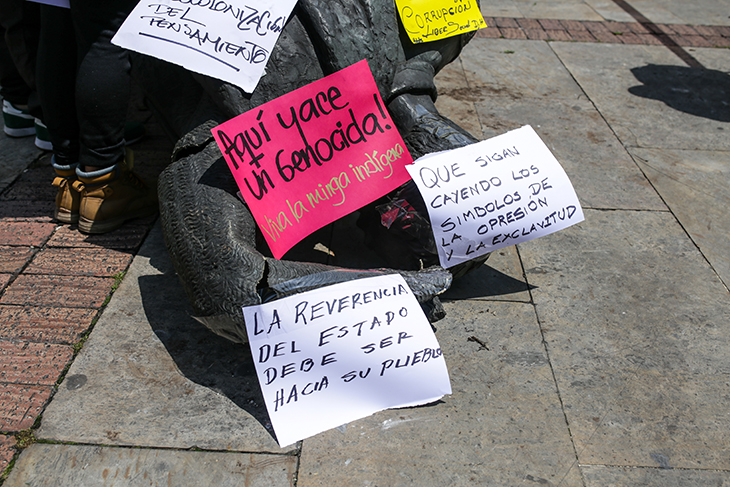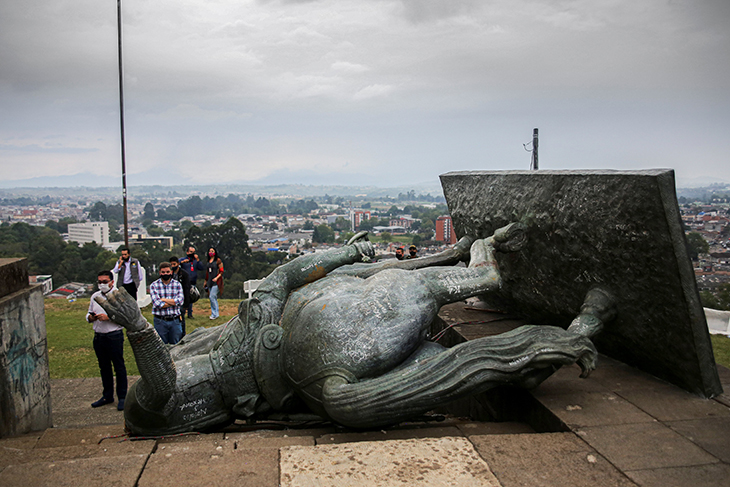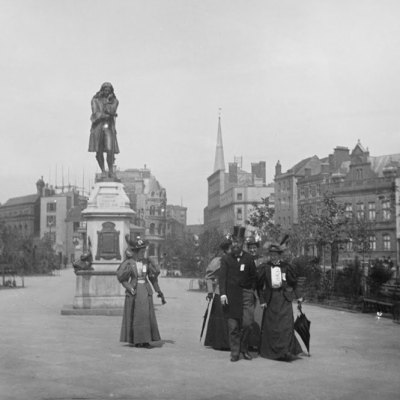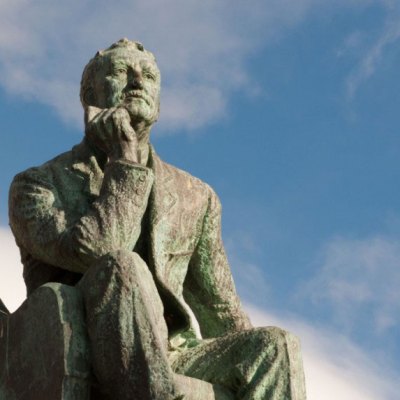On 16 September 2020, members of the Misak indigenous community toppled the statue of the Spanish conquistador Sebastián de Belalcázar (1480–1551) in the city of Popayán in the south-west of Colombia. ‘When they told me they had toppled the statue, I cried, cried for half an hour, and I shouted. Every time I see it’s gone it makes me very happy,’ says the indigenous leader Tatiana Batiller, who is known as Mamá Tatiana among the Misak people, and lives in the south-western town of Silvia.
Batiller explains that the toppling took place after Misak authorities staged a ‘trial’ of Belalcázar last June. This concluded that the founder of the cities of Cali and Popayán needed to be ‘rewritten in universal history as guilty of genocide’ of the peoples who lived in the Pubenza valley at the time, as borne out by chronicles of the conquest, various archives, Misak oral tradition, and modern historians. A written statement signed by ‘the descendants of the Pubenenses’ was published after the trial: ‘We declare that the statue erected in the 1930s […] when the city of Popayán commemorated the 400th anniversary of the defeat of our peoples under the genocidal Spanish yoke, is part of the symbolic violence which crushed us and put us in a place of oblivion.’
The statue of Gonzalo Jiménez de Quesada after it was torn down by members of indigenous groups in Bogota, Colombia, on 7 May 2021. Juancho Torres/Anadolu Agency via Getty Images

More statues fell during a wave of mass protests against a tax reform proposed by the government of Iván Duque in April this year. On 28 April, members of the Misak community brought down a second statue of Belalcázar in the south-western city of Cali. A few days later, in the capital, Bogotá, Misak protesters destroyed a statue of another conquistador, Gonzalo Jiménez de Quesada, who founded the city in 1638. Soon, not only members of the Misak community were tearing down statues. In June, in the northern city of Barranquilla, anti-government protesters toppled the statue of Christopher Columbus. In the same month, protesters attempted to tear down the statues of Columbus and Isabella I of Castile (who sponsored the explorer’s first voyage in 1492) and painted them red, which led the culture ministry to remove the figures ‘for safety reasons’.
‘We, as Misak, don’t have anything against statues,’ Batiller says. ‘We have a problem with what’s being represented in public space, which supposedly should be built collectively, but doesn’t encompass narratives that have been silenced. Who remembers Taita Payán, the Misak leader who fought and resisted [the Spanish] for around 20 days and gave his name to Popayán? He’s been relegated to oblivion, like Taita Calamba and Taita Yazguen […] but they’re part of ancestral peoples’ memory and we would like them to be present in public space, not only at a material level, but also in public debate.’
According to Batiller, in the 1930s wealthy land-owners emphasised attachment to their Spanish heritage in places that had other associations for indigenous people. She says that the Belalcázar statue in Popayán was erected on a sacred site, originally a pyramid, which was cut and razed and that archaeological excavations started in the 1950s by Julio Cesar Cubillos unearthed a whole funerary complex.
The statue of Sebastián de Belalcázar in Popayán, Colombia, after it was pulled down on 16 September 2020. Photo: Julian Moreno/AFP via Getty Images

Of course, battles about the past are also about the present. For Batiller, ‘many, inherited, colonial practices are present in the despotism of Iván Duque’. As Patrick Morales, head of the District Institute of Cultural Heritage (IDPC) in Bogotá, tells me: ‘Indigenous peoples are not only questioning the past. They’re saying “we keep being murdered now”.’
The peace agreement signed in 2016 between the previous government and the Farc guerrilla group raised hopes that indigenous people might be able to live in peace on their lands. But they continue to be targeted by paramilitaries and dissident rebels who vie for control of coca crops or mining territory. According to the Institute for Development and Peace (Indepaz), 12 indigenous leaders have been killed in the first three months of 2021. Critics of the president say he has undermined the peace agreement.
But what is to become of the fallen conquistadores? For Batiller, their statues should be relegated to ‘a museum of infamy’. Morales thinks it’s likely that the de Quesada statue, which is now missing its sword, will go to the Bogotá museum. ‘But how to take it there? Should it be restored or should the traces [of what happened] remain?’ The National University of Colombia has proposed that the statue (or a copy, as the original is too heavy) should retrace the conquistador’s journey along the Caribbean coast, starting in Santa Marta, which is the first point de Quesada reached, before heading to Bogotá. ‘It would be a public history lecture,’ Morales explains, ‘a journey retracing the Conquista to load Gonzalo Jiménez de Quesada with other meanings before bringing him to the museum.’
In Bogotá, the statue of de Quesada was briefly replaced by an iron statue of Dilan Cruz, an 18-year-old who was killed in November 2019 after taking part in a protest demanding better access to education. The statue, signed by the Colombian artist John Fitzgerald, was later removed by the city council. Bogotá’s Monument to the Heroes, designed by the Italian architect Angiolo Mazzoni, who sought refuge in Colombia after having worked for Mussolini’s regime, has now turned into a meeting spot (and a canvas) for protesters.
In Popayán, Batiller tells me, there has been a consensus among local artists that no monument should be built on what is actually an important heritage site. She says that in Cali, there are a number of propositions (and memes!) about what could replace Belalcázar: the statue of an Afro-Colombian woman of the Pacific coast or a chontaduro (peach palm fruit) as a symbol of the coast. Not everyone, however, agrees that new statues should be erected. Morales says, ‘It’s the whole set-up that’s wrong, this idea of monuments that never die, when heritage keeps evolving.’ The IDPC has launched an architectural competition for the square where the statue of de Quesada used to stand, to turn it into ‘a democratic meeting point’.
Last spring, Iván Argote, a Colombian artist who lives in Paris, made a film staging – with the help of special effects – the removal of a statue of Joseph Gallieni, the French general known for his brutal colonisation of Madagascar. Almost 10 years ago, the artist started making Turistas, a series of photographs in which he covered statues of Spanish kings and conquistadores in colourful ponchos and woolly hats. ‘So much of the beauty and the wealth of Spain was actually made possible by their colonies, this was my attempt at making a more honest monument, a monument that would show our mixed heritage, and to make fun of these images of power that are somehow obsolete. I called them Turistas, like these Europeans who go to Machu Pichu and wear all the indigenous attire,’ he says.
At the height of the protests in Colombia, members of the Misak community proposed rebaptising streets. Avenida Eldorado in Bogotá was renamed ‘Avenida de los Pueblos Originarios de Nupirao’ (‘The Avenue of the Ancestral Peoples of Nupirao’, a term for ancestral land, in this case, America). The name doesn’t seem to have stuck. But one day, perhaps even the name of the country could change. ‘After all,’ says Argote with a smile, ‘Columbus never set foot in Colombia!’


